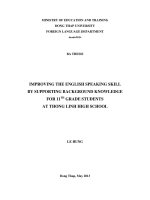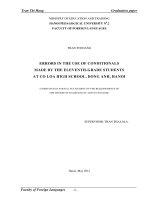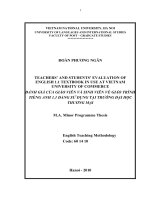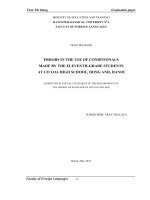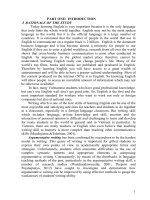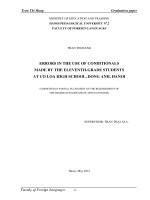The warm up activities in motivating the 11th grade students at uong bi high school to develop their reading skills
Bạn đang xem bản rút gọn của tài liệu. Xem và tải ngay bản đầy đủ của tài liệu tại đây (934.29 KB, 68 trang )
ĐẠI HỌC THÁI NGUYÊN
KHOA NGOẠI NGỮ
NGUYỄN THU PHƯƠNG
THE WARM-UP ACTIVITIES IN MOTIVATING
THE 11TH GRADE STUDENTS AT UONG BI
HIGH SCHOOL TO DEVELOP THEIR
READING SKILLS
2018
i
ACKNOWLEDGEMENTS
The study would not have been completed without enthusiastic support
and encouragements of many people.
First of all, I would like to express my special thanks to my supervisor, Dr.
Nguyen Thanh Long who has contributed to my study with a wide multitude of
useful suggestions, critical comments, valuable advice and encouragements.
I also would like to thank the teachers from School of Foreign languagesThai Nguyen University, who have given me useful advices and conditions for
the completion.
My sincere acknowledgement of all English teachers and students at Uong
Bi high school who have helped me to carry out the surveys for my research.
The study has been progressed with all my attempts but there have been
still limitations and mistakes. Therefore, I look forward to receiving sincere
comments from all of you!
ii
ABSTRACT
This study aimed at investigating how to develop situation of teaching
and learning by using motivational activities. The study addresses issues of
teachers’ and students’ attitudes towards warm-up activities in reading
lessons, students’ favorite activities, problems the teachers encounter when
conducting warm-up activities in teaching writing lessons, students'
assessments on the benefits of warm-up activities and finding out some
suggested warm-up activities applied to teach reading lessons with the aim to
make teaching and learning reading more effective.
The participants of the study included 6 English teachers and 122
students of the 11th grade at a High School. The data were collected by means of
questionnaires and class observations, but the main one is the questionnaires.
Both the quantitative and qualitative research methods were employed in this
study. Data analysis was mainly based on the quantitative method. The
collected information was analyzed, compared, commented, and presented
under the forms of tables.
The result of the study provided encouraging evidence to indicate that
most of the teachers and students at Uong Bi High School appreciate the role of
warm-up activities in teaching and learning reading lessons. However, the
survey revealed that there were a number of difficulties that existed in reading
lessons used warm-up activities.
Some detailed suggestions are recommended within the wish to
contribute to the improvement of teaching and learning reading skills through
warm-up activities.
3
TABLE OF CONTENTS
PART A: INTRODUCTION....................................................................................1
1. Rationale for the study ...................................................................................1
2. Aims of the study ...............................................................................................2
3. Research questions.............................................................................................2
4. The scope of the study .......................................................................................2
5. Significance of the study....................................................................................3
6. Method of the study:..........................................................................................3
7. Design of the study .............................................................................................3
PART B: DEVELOPMENT.....................................................................................5
CHAPTER 1: LITERATURE REVIEW................................................................5
1.1. Theoretical background of reading ...........................................................5
1.1.1. What is “reading”? ..................................................................................5
1.1.2. What is “teaching reading”? ...................................................................6
1.1.3. The importance of reading ......................................................................6
1.2. Warm-up activities in teaching and learning............................................7
1.2.1. What is “warm-up”? ...............................................................................7
1.2.2. The importance of warm-up activities ....................................................9
1.3. Motivation ....................................................................................................9
1.3.1. Definition ................................................................................................9
1.3.2. Using games to motivate students in warm-up activities .....................10
1.3.2.1. Definition of game .............................................................................10
1.3.2.2. Games motivate learner .....................................................................11
1.4. Reading motivation....................................................................................12
1.4.1. Organismic Theories of Motivation......................................................13
1.4.2. Relating motivation to read and emergent reading skills: A ................13
measurement validation study
............................................................................13
1.4.2.2. Motivation for reading ...................................................................14
1.4.2.3. Motivation and engagement...........................................................15
1.4.3. Motivating students to actively engage in reading ...............................15
CHAPTER 2: METHODOLOGY.........................................................................17
2.1. Setting of the study .......................................................................................18
4
2.2. Participants of the study ..............................................................................18
2.3. Research methodology..................................................................................18
2.3.1. Methods of data collection .......................................................................19
2.3.1.1. Questionnaire .....................................................................................19
2.3.1.2. Questionnaire for students .................................................................20
2.3.1.3. Questionnaire for teachers .................................................................20
2.3.2. Class Observations ...................................................................................20
2.3.3. Methods of data analysis ..........................................................................21
2.4. Data collection and analysis of observations ..............................................21
2.5. Description of situation ................................................................................23
2.6. Material..........................................................................................................24
2.7. Data collection and Procedures ...................................................................24
2.7.1. Collection of the Questionnaire Data .......................................................24
2.7.2. Collection of the Class Observation Data ................................................25
CHAPTER 3: RESULTS AND DISCUSSION ....................................................27
3.1. Research results ............................................................................................27
3.1.1. Data analysis of the students’ survey questionnaires ...............................27
3.1.1.1.The situation of learning reading skills at the 11thgrade inUong Bi
high school ......................................................................................................27
3.1.1.2. How warm-up activities motivate students in reading lessons ..........29
3.1.2. Data analysis of the teachers’ survey questionnaires ...............................31
3.2. Data analysis of the class observation .........................................................32
3.3. Discussions .....................................................................................................33
3.3.1. Situation of learning reading in Uong Bi high school..............................34
3.3.2. How warm-up activities motivate students in reading lessons ................34
3.3.3. The situation of teaching to develop students' reading skills ...................35
3.4. Summary........................................................................................................35
PART C: CONCLUSION.......................................................................................35
1. Conclusions of the study .....................................................................................36
2. Suggested games and other activities for warm-up in reading lessons at Uong
Bi high school ...........................................................................................................38
2.1. Games for warm-up activities collection ....................................................38
5
2.1.1. Board Race ...............................................................................................38
2.1.2. Hangman ..................................................................................................38
2.1.3. Pictionary..................................................................................................39
2.1.4. Hot seat .....................................................................................................39
2.1.5. Chain game ...............................................................................................40
2.1.6. Noughts and Crosses ................................................................................41
2.1.7. Lucky numbers .........................................................................................42
2.1.8. Slap the board ...........................................................................................43
2.1.9. Network ....................................................................................................43
2.1.10. Pass the ball ............................................................................................44
2.2. Other activities for warm-up .......................................................................44
2.2.1. Songs ........................................................................................................44
2.2.2. Discussion ................................................................................................45
REFERENCES ........................................................................................................46
6
LIST OF TABLES
Table 1.1: Situation of learning reading inUongBihighschool .......................27
Table 1.2: How warm-up activities motivate students in reading lessons ......29
Table 1.3: The situa tio n of teaching to dev elo p students’ reading skil
lsin a
high school ......................................................................................................31
vii
PART A: INTRODUCTION
1. Rationale for the study
English has been considered to be an integral subject for students from
Primary school system to University system. In fact, there are a lot of parents
who orient their children need to learn English at age of three. Furthermore,
English clubs and English centers are developed over provinces in Vietnam.
This means that English is being more and more appreciated. However, how
do learners find out the most effective method to teach and learn English? It is
concerned by a great deal of teacher, parents and students. How to teach four
basic language skills such as speaking, listening, reading and writing is
thoughtful consideration. Of these four skills, reading skills are paid attention
by numerous students; however, to start a lesson that makes students feel
contented is not straightforward. Besides, how to motivate students in the
warm-up activities is the anxiety of many teachers.
Warm-up activities in language classes have been a prominent topic in
methodology. In fact, this is the beginning of a lesson and has a great impact on
the classroom, excitement and efficiency of the class. Recognizing this fact and
the importance of this aspect, the thesis title “The of warm-up activities in
motivating the 11th grade students at Uong Bi high school to develop their
reading skills” was conducted with the hope of contributing to some extent to
the teaching method and providing some informative knowledge.
Reading skills are a weighty skill at high schools because reading
comprehension is always appeared in midterm exams, semester exams, and
entrance exams. However, it is also a complicated skill. Many students feel that
learning reading skills is intricate and tiresome. Motivating students has a
positive impact on learning because they take an advantage of a given
opportunity and show intense effort and concentration in the implementation
1
of learning process. So how to motivate students to learn reading skills better is
an aspect that teachers need to concern about. To make an English teaching
period effectively, the teacher has to create the learning environment to
motivate students from the beginning.
There are numerous ways to motivate of students in reading lesson and
warm-up activities as one of the most effective ways. An effective warm-up can
also be a high-quality way which helps students to feel more excited with a
reading lesson.
Based on the consideration above, the present study tries to investigate
the warm-up activities in motivating the 11th grade students to develop their
reading skills.
2. Aims of the study
The study was conducted with the aims to:
- Improve reading skills of high school students
- Motivate students to participate in warm-up reading activities.
3. Research questions
The following research questions were investigated in the study:
1. How does the use of warm up activities increase the level of high school
students’ motivation for reading in English?
2. How does the use of warm up activities improve high school students’
reading
comprehension in English?
4. The scope of the study
There are various warm-up activities to apply for reading lessons. That is
why the researcher cannot cover all the knowledge related to the topic.
However, the most important items about reading skills and warm-up activities
to motivate students are mentioned in this study.
2
Due to limit of the thesis, only one high school was chosen as the
research setting. This study included warm-up activities used in teaching and
learning reading skills in 11thgrade.
5. Significance of the study
The findings of the study contributed a number of strong points to
students, teachers, and researchers of the related fields.
First of all, teachers received benefits from the information the research
provides. Teachers would have an overview look at the benefits of warm-up
activities.
Secondly, the study was also significant for the students. It was expected
that the students could learn reading skills more effectively.
Finally, the study could give contribution to other researchers as
references in conducting further researches.
6. Method of the study:
The researcher decided to use quantitative method because the main
content of this study would be based on the data collected from questionnaires
to collect, analyze and tabulate the data. However, quantitative method alone is
not reliable and valid enough to have strong evidence for the study. The
adoption of both quantitative and qualitative methods would help the
researcher collect the most precise and pertinent information for the study.
This study followed method steps below: (1) Prepare questionnaires for
teachers and students; (2) Collect data from questionnaires to analyze tabulate
the data; (3) Attend teachers who teach reading skills with different warm-up
activities; (4) Observe students' attitudes, classroom atmosphere, the things
that students can improve after lessons with warm-up activities.
7. Design of the study
This minor thesis is divided into three parts:
3
Part A with the title “INTRODUCTION”. This part provides information
about the reason for choosing the study, the aims, the scopes, method and the
design of the study.
Part B with the title “DEVELOPMENT” includes three parts:
Chapter 1 is “LITERATURE REVIEW”, which provides all information
related to the study.
Chapter 2 discusses “METHODOLOGY”, which studies subjects and
methods of study as well as the analysis of data collected.
Chapter 3 is about “RESULTS AND DISCUSSION”, which results from the
investigation of the factual situation in teaching and learning reading and the
use of warm-up activities to motivate the 11th grade students at Uong Bi high
school.
PART C is “CONCLUSION” which gives an overview on the achievement
of the thesis and suggests warm-up activities for reading class in high school.
4
PART B: DEVELOPMENT
CHAPTER 1: LITERATURE REVIEW
1.1.
Theoretical background of reading
1.1.1. What is “reading”?
There are voluminous definitions of reading. In language teaching, we
talk about four language skills such as reading, listening, speaking and writing.
Concerning the definition of reading, in 2016, Hansen wrote “Reading is
basic to all learning, both in learning in general and in acquisition of languages.
Society is highly dependent on knowledge and information. It is vital to be able
to navigate in these sources and search out what is needed. This requires
multiple skills, as the ability to navigate in the text overflow, to read multimedially, digitally, and inter textually, in addition to the mere comprehension
of the written text and its words, phrases, structure, and genres. In a
knowledge society it is necessary to acquire the ability to understand,
integrate, and combine information from multiple sources”.
Meanwhile, Schoenbach (1999, p.147) stated that “Reading isn’t just a
basic skill. Numerous people think of reading as a skill that is taught once and
for all in the first few years of school. In this view of reading the credit for
students’ reading ability goes to primary grade teachers, and upper elementary
and secondary teachers at each grade level need teach only new vocabularies
and concepts relevant to new content. Seen this way, reading is a simple
process: readers decode each word in a text and then automatically
comprehend the meaning of the words, as they do with their everyday spoken
language. This is not our understanding of reading.”
Consequently, on website Ravinder defined that “Reading is a cognitive
process that involves decoding symbols to arrive at meaning. Reading is an
5
active process of constructing meanings of words. Reading with a purpose
helps the reader to direct information towards a goal and focuses their
attention. Notwithstanding the reasons for reading may vary, the primary
purpose of reading is to understand the text. Reading is a thinking process. It
allows the reader to use what he or she may already know, also called prior
knowledge. During this processing of information, the reader uses strategies to
understand what they are reading, uses themes to organize ideas, and uses
textual clues to find the meanings of new words. Each of the three components
of reading is equally important.”
Besides, according to Halim (2006), “Reading is a receptive language
process. It is the process of recognition, interpretation, and perception of
written or printed materials. Reading proficiency plays a great role in
understanding a written statement accurately and efficiently. Reading serves as
an important tool in every field of professional service.” In conclusion, reading
is believed to be one of the most challenging skills and should be paid more
attention in both learning and teaching. This research seems to be coincided
with viewpoint of Abdul Halim on reading.
1.1.2. What is “teaching reading”?
Indeed, the teaching of reading has been an essential part of learning a
language ever since foreign language began to be taught (Kelly, 1969). Jiao
(2007) discusses that reading teaching becomes teaching of language points
known as grammar and vocabulary. This kind of English reading teaching to a
great extent hinders EFL students’ language proficiency. According to Grelllet
(2001), reading helps in mental development and is known to stimulate the
muscles of the eyes. Reading is an activity that involves greater levels of
concentration and adds to the conversational skills of the reader.
1.1.3. The importance of reading
Cotter (2009) states that “Because it's the first activity of the lesson,
6
the warm-up activities set the tone for the next ninety minutes. An activity that
students find too difficult, or even confusing, results in a class of disinterested
zombies. Similarly, a writing-based activity won't get the students
communicating. This then translates into a quiet class session in which you
have to prod and push the students to volunteer examples or simple answers.
Fun warm up, on the other hand, raises energy levels. Fun activities also
produce relaxed, less inhibited students. With the right warm up, you'll have
created a positive atmosphere to practice and experiment with the language.”
On
website
/>
start-with-a-warmer.html, according to Andrei Zakhareusk, a lesson which is
started with a warm-up activity is important for a number of reasons. The
students “need a chance to settle down into the class and get their minds
focused on the lesson ahead. Delving straight into difficult subject matter isn’t
going to help them in the least bit.” He also defines that a warm up lesson sets
the tone for what is to take place during the class. This is a great idea for many
reasons. Students have some idea of what to expect, and the topic can easily be
introduced to them. For example, if one is teaching a business class about
imports and exports, one will have a warm-up exercise where the students can
test their own knowledge of related vocabulary. They are allowed to “start off
in a single train of thought in order to keep them on track for the remainder of
the class.”
1.2.
Warm-up activities in teaching and learning
1.2.1. What is “warm-up”?
In the classroom, warmers are not isolated activities but can serve to
introduce a topic or to recycle some previously learnt language in an enjoyable
way. That means that students are not only reminded of what they have learned
but also have a general view of what they will learn.
7
On
website
/>
bin/lessons/index.pl?read=5042, LeBlanc shows that there is also a close-up
view of warm up activity. “A warm-up activity is the perfect time to review
language skills presented in the previous English lesson. Some students will
have mastered these skills since the last session and will be proud to show
them off, and others will be happy to have the chance to review material they
are not completely comfortable with yet. Reviewing the material in a warm-up
activity that is different from the one you used to practice the English language
skill in the last lesson will also give your students the opportunity to hear and
use the material in a new way before moving on to the next lesson.”
In the classroom, warmers are not core activities but can apply to
introduce a topic or to reuse some reuse vocabularies which are learned in
previous lessons in an enjoyable way. That means that students are not only
reminded of what they have learned but also have a general view of what they
will learn.
According to Robertson & Acklam (2000), “warm up is a short activity
for the beginning of lesson” (p.30). Warm-up activities are actually used in the
first part of a lesson. These activities make the classes’ atmosphere more
vividly and help students act or express their knowledge, their feeling in a
comfortable state without evaluating their abilities. So, students do not have to
worry about their marks, their understandings of various fields.
Lassche (2005) defines that for language learning lesson a warm-up
stage is the “initial orientation” (p. 83). An initial orientation is really
important to a new lesson. The first orientation helps students remember
vaguely about topics.
According to Lam (2005) in her mater thesis “Warm up activities for
speaking class in high school”, she states that warm-up activity is a kind of short
activities which is used to break the “ice” in classroom and make it “hot” from
the beginning of each period of language class. They are short, simple and
interesting enough to motivate students to learn a foreign language better. In
8
addition, a warmer is an activity at the start of the class to warm up the
learners. They tend to be short, dynamic activities. Warmers can be compared
to coolers, which are short activities to finish the class.
1.2.2. The importance of warm-up activities
Allwright (1984) states that warm up activities are designed to attract
students’ attention, to help them put aside distracting thoughts, and to get them
ready to focus individually and as groups on whatever activities that follow.
Additionally, on Oxford Pocket Dictionary of Current English (2009), warm-up
is defined as “a period or act of preparation for a game performance or exercise
session, involving gentle exercise or practice.” In The Oxford Advanced
Learners’ Dictionary 8th Edition, warm-up is “a short practice or a series of
gentle exercises that you do to prepare yourself for doing a particular sport or
activity.” In fact, students always feel distracted, unoccupied or lack of
discussion in new lesson after a short break. So, warm-up activities not only
help students balance their emotion, but also help them lead to the lesson in an
interesting way. Besides, warm-up activities contain the meaning of the topics
that they are learning in order that they have a general view in reading lessons’
content.
According to García and Martín (2004), one of the objectives of using
warm up activity is to activate students’ background knowledge. Teachers need
to understand what students already know about the topic they are going to
teach and they need to connect the topic with the students’ present
understanding.
García
and
Martín
(2004)
also
mention
from
the
methodological point of view that we can assume warm-up as a ship that takes
the learners for a journey from known to unknown as an attempt to activate
their potential and passive vocabulary (p. 17).
It means that the warm-up
activities can help teachers to check their students’ understanding about
reading topics. This is also a good way for teachers to orient new things in a
reading lesson.
1.3.
Motivation
9
1.3.1. Definition
10
“Motivation is typically defined as the forces that account for
thearousal, selection, direction and continuation of behavior.” (Biehler&
Snowman, 1997). Mitsalina (2015, p.33) claimed motivation as interest in and
enthusiasm for the material used in class; persistence with the learning task, as
indicated by the levels of attention or action for an extended duration; and
levels of concentration and enjoyment.”
“Motivation is one of the important factors that influence English
learning achievement. Motivation is
one
of
the
keys
to
successful
language learning. Maintaining a high level of motivation during a period of
language learning is one of the best ways to make the whole process more
successful” (Cáceres, p.7). Therefore, in order to help the students to maintain
a proper strength in English learning motivation is very necessary for the
teachers in the daily teaching procedure.
1.3.2. Using games to motivate students in warm-up activities
Language learning is hard work “ Effort is required at every moment and
must be maintained over a long period of time. Games help and encourage
several learners to sustain their interest and work. Games also support the
teacher to create contexts which the language is serviceable and meaningful.
The learners would like to take part and in order to do so must understand
what others are saying or have written, and they must speak or write in order
to express their own point of view or give information.” (Cáceres, 2010).
1.3.2.1. Definition of game
A game is an activity with rules, a goal and an element of fun. Games
should be regarded as an integral part of the language. Games can be used at
“all stages of the progression from controlled to free practice, serving at one
end of the range as a memory aid and repetition drill, at the other as a chance
to used the language freely and as a means to an end rather than an end in
itself. They
11
can also serve as a diagnostic tool for teacher, who can note areas of difficulty
and take appropriate remedial action.” (Haldfield, 1999).
“The term ‘game’ is used whenever there is an element of competition
between individual students or teams in a language activity.” Greenall (1990)
As definition of game mentioned by Caillois (1957), there are some
notable characteristics as follows:
fun: the activity is chosen for its light-hearted character
separate: it is circumscribed in time and place
uncertain: the outcome of the activity is unforeseeable
non-productive: participation is not productive
governed by rules: the activity has rules that are different from
life
everyday
fictitious: it is accompanied by the awareness of a different reality”
In summary, games can be seen as a popular activity which is used to
warm-up a reading lesson. Almost all teachers apply games to start a study.
This proves that games have a tremendous impact on teaching. However, the
researcher also found that other forms of warm-up were limited.
1.3.2.2. Games motivate learner
The main reason why games are considered as “effective learning aids is
that they spur motivation and students get very absorbed in the competitive
aspects of the games; moreover, they try harder at games than in other
courses.” (Avedon & Sutton-Smith, 1971)
As Jacobs & Liu (1996) declares that many games can be played in pairs
or in small groups, thereby providing a venue for students to develop their
skills in working with others such as the skill of disagreeing politely and the
skill of asking for help.” In most games, students must play in groups, where
everyone has an opportunity, encouraging everyone to play turn-based games
rather than letting someone else do all or join the game from the beginning
until the end.
12
According to Duong (2008), 90% of his students confided that they could
remember new words faster and better due to the relaxed atmosphere created
by playing games. This is doubly reinforced by the same sentiment that
“students tend to learn better, when it is applied in a relaxed environment like
playing games. In fact it has been proved that an interested and involved class,
learning through several fun-filled English language games takes in 100% of
the lesson and retains 80% of it.” The meaning of the language students listen
to, read, speak and write will experience more vivid in a game; therefore, they
will better remember the language they learnt. (Huyen and Nga, 2003).
Further support comes from Zdybiewska(1994: 6): “ games are a good
way of practicing language, for they provide a model of what learners will use
the language for in real life in the future exercises that practice and utilize the
new language have been completed, games can then be introduced as yet
another means for enabling greater comprehension.” As strongly emphasized
above, games can motivate learners, promote learners’ interaction, and
improve learners’ acquisition. As a result, games can increase students’
achievement, learners’ test scores, ability to communicate, some skills,
vocabulary knowledge or other language skills can improve.
The advantage of games in improving learners’ achievement was
emphasized by Riedel (2008), we are teaching a new generation of students,
which requires unconventional teaching strategies were put into practice in the
classroom. And when schools use the games, the student benefits speak for
themselves - a greater desire to learn and higher test scores.
In short, games prove to be a useful tool used frequently in language
teaching. The game not only provides the learner with a highly motivated,
relaxed, practically meaningful classroom with all the language skills.
Therefore, games can motivate learners, promote learner interaction, improve
learning, and increase their performance.
1.4.
Reading motivation
1.4.1. Organismic Theories of Motivation
Organismic theory has many forms, but some basic assumptions allow us
to describe them in a positive way. Biological approaches tend to be primarily
mechanistic by focusing on the role of cognitive and effective processes as
determinants of behavior. For example, according to Deci (1975), humans’
thoughts and feelings determine the lawful and ordered way they act on their
environment. In addition, the emphasis here is on the factors that are illegally
defined and ordered to occur within the body as opposed to mechanics’ focus
on external factors. Thus, the advice concerning classroom motivation derived
from organismic theories exhorts teachers to focus on the inherent
motivations of children. For instance, White (1959) has proposed that
motivation is an expression of an inborn need to be effective or competent.
Students have been oriented how to find new information as well as make
sense of what they know in order to seek more. According to Maslow (1943), he
claimed that a motivation theorist and psychologist, proposed a theory of
motivation founded on human needs. Maslow developed a hierarchy of needs
consisting of the following five levels: physiological, safety, love and belonging,
self-esteem, and self- actualization.
He viewed these needs in a prepotency fashion where one need
essentially occupies an individual’s attention until satisfied. After a need is
adequately satisfied, the next prepotents need arises. While the concern of this
article is on increasing cognitive abilities, which are in the self-actualization
stage, the interdependency of all human needs will not and should not be
ignored. Reading is not just a mechanical tool to be learned, it is an intricate
part of the entire person; affected by his or her needs, attitudes, self-concept,
and emotions.
1.4.2. Relating motivation to read and emergent reading skills: A
measurement validation study
1.4.2.1.
Relating motivation to read
Gambrell, Morrow, & Pressley (2007) claim that they implement
balanced instruction, teachers provide a context ripe for successful reading
development though inclusion of explicit instruction, modeling, scaffolding,
facilitating, and participating According to
Pearson, Raphael, Benson,
&Madda (2007, p.39), among their repertoire of skills, independent readers
automatically recognize words, use skills and strategies to access text, and are
fluent text processors. Hoffman & McCarthey(2000) believes that learners
develop essential skills as well as appreciate and desire to support successful
reading comprehension. The engaged reading model considers motivation,
strategies, social interactions, and conceptual understanding to be the
ingredients for successful reading. Therefore, Guthrie & Anderson (1999, p.20),
Guthrie & Wigfield (2000) were thought that model provided an explanation as
to how balanced instruction supports the development of independent
readers. Of particular interest in the current research was the motivational
aspect of engaged reading. The motivations of an engaged reader included,
among other constructs, involvement, curiosity, challenge, importance, and
efficacy. Hence, students were promoted through reading skills is actually
important for learners. Students have more opportunities to innovate and
discover inspiration in their classes.
1.4.2.2.
Motivation for reading
Guthrie & Wigfield (1997) pointed out that motivation to read was a
central feature of reading engagement and overlaps with other features of
reading engagement such as reading competency, utilitarian aspects of reading,
and social aspects of reading. Reading engagement theory and researching on
children’s reading motivation have focused on intrinsic and extrinsic
motivation to read. Moreover, he claimed that intrinsic and extrinsic
motivation might lie on a continuum of self-determination. According to Ryan &
Deci (2000), the non self-determined end of the continuum was external
regulation, which involves complying with the requests of others in order to
receive anticipated rewards
or avoid punishment. At the self-determined end of the continuum was intrinsic
regulation, which involved showing behaviors out of interest, enjoyment, and
the inherent satisfaction they bring. Research has shown that both extrinsically
and intrinsically regulated motivation predict how children read; however, of
the two, intrinsic motivation was the better predictor.
1.4.2.3.
Motivation and engagement
There are a few studies which discussed about teacher’s knowledge and
their trust in motivating to read. In one of the few studies, Sweet, Guthrie, &
Ng,(1998) investigated teacher perceptions of students’ intrinsic motivation for
reading from the perspective of self-determination theory (SDT; Deci & Ryan,
1985) and reading achievement. Although his study didn’t relate directly to
what teachers believed in motivating students, the engagement of those beliefs
can be made based on his research. To evaluate our students in motivation
features, these included individual, topical, activity-based, autonomysupported, socially supported, and writing-related features.
1.4.3. Motivating students to actively engage in reading
According to Rupley, Ash & Blair (2006), Assessing the impact of
motivational strategies on students’ reading seems “to be the key to promoting
successful learning.” Regardless of whether one is inclined towards “an
intrinsic or exogenous approach in motivating” reading in the classroom,
“attention to how the approach” impacts on learning should be assessed.
“Some basic evaluation concerns related to motivation and reading instruction
are presented below.”
Firstly, students who actively participate in a reading activity because
they find it interesting and meaningful and they will probably not show
increased engagement if an extrinsic reward is employed. In addition, the
introduction of an extrinsic reward will decrease students' motivation in a task
they find interesting in many cases.
Secondly, the use of external rewards can be delayed when students are
still interested in activities. However, if participation in the task begins to
decline, the teacher may wish to introduce some external reward to re-engage
the student's interest. Engaging in reading tasks with negative emotions can be
“enhanced by external motivational strategies.” The effects of extrinsic rewards
will probably decrease in sustaining students’ engagement over varying time
periods. That is, “students may begin to associate less value with a reward as it
is used over any length of time.” Being closely involved with the way external
motivators are maintaining desired reading behaviors will allow the teacher to
make the necessary adjustments to the active participation of the students.
Thirdly, “It appears that the lack of appropriate reinforcers is more
damaging to intrinsic motivation than is their use (Bates, 1979). In terms of
classroom reading instruction this suggests that for tasks where students
already have developed some association with extrinsic rewards. Therefore, the
lack of these rewards could lead to negative effect.
McGeown, Norgate & Warhurst (2012) claim that previous studies often
test the reading dynamics of groups of children with a wide range of reading
ability, focus on the relationship between motivation and reading skills.
However, there is very little research that has identified whether children with
excellent reading skills or children with very poor reading skills show different
relationships between their motivation and reading skill. These groups of
readers will have had very different experiences when reading therefore can
prove the different relationships between skill and motivation.
He also pointed out that determining the difference at the group level is
very important, as it demonstrates the presence of the variation in established
relationships and can highlight important aspects. It should be considered in
specific groups. He also put forward the views of Logan and Johnston (2009)
and Logan and Medford (2011) also argue that boys, in particular, identify
ways to increase their attitudes toward reading and reading motivation. It is
particularly important because their attitudes and motivation are more closely
matched to their reading skills and performance in reading tests. In addition,
Oakhill and Petrides (2007) show that “when choosing a reading test topic, the
topic of concern for boys should be considered in detail, the importance of the
degree of
attention to reading comprehension. However, the current study does not focus
on gender differences.”
On the other hand, in 2011, Logan, Medford, Hughes have compared good
and bad things. Readers are poor in their internal reading dynamics and find
that while readers' internal reading impotence predicts differences in their
reading skills, good motivations of the reader are not. These studies have been
well and poorly controlled. Therefore, the average reader will be included in
these samples good and poor readers. The purpose of this study was to test the
children for their reading skills, as there were far fewer studies comparing
these groups.
There are various studies about motivate students in reading activities.
Each study also demonstrated that they studied different levels of learners and
were mostly intermediate level.
Concerning the warm-up activities in motivating students to develop
their reading skills, in 2015, Nhung wrote “The use of warm-up activities in
motivating 10th form students to learn reading skill” in her MA thesis. This
study explored the use of warm-up activities and their effects on the 10 th form
students at Kien An High School and make some suggestions to improve the
quality of learning reading lesson. This study was conducted to find out
definition of warm-up activities and warm-up activities are effective techniques
for motivating 10th form students to learn reading skills or not.
CHAPTER 2: METHODOLOGY
This chapter presents the setting of the study, subjects and methods of
study as well as the analysis of data collected.
